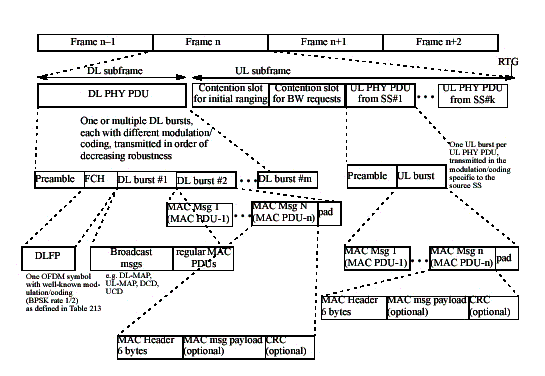
WiMAX is the commonly used name for signals in compliance with the IEEE 802.16-2004 standard. The standard defines different physical layer specifications for the 2-11 GHz system. This software application uses a 256-carrier Orthogonal Frequency Division Multiplex (OFDM) physical layer (PHY).
OFDM uses frequencies that are orthogonal; that is, they don't interfere with one another. This allows the spectrum of each subchannel to overlap another, greatly reducing the required bandwidth. OFDM is also able to resist the effects of multipath by using its parallel, slower bandwidth nature.
In 256 OFDM there are 192 data subcarriers, eight pilot subcarriers and 56 nulls. In this case, a data stream would be split into 192 parallel data streams, each at 1/192 of the original rate. Pilot subcarriers provide a reference to minimize frequency and phase shifts during the transmission. Null carriers allow for guard bands and the DC carrier (center frequency).
WiMAX systems can be deployed as TDD (time division duplex), FDD (frequency division duplex), or Half Duplex FDD using frame-based transmission. For FDD, the downlink and uplink signals are transmitted simultaneously at different frequencies. The downlink and uplink frames are basically the same as described below for the corresponding TDD subframes.
In TDD mode, each frame is divided into DL (downlink) and UL (uplink) subframes separated by transmit/receive and receive/transmit transition gaps, as shown below in the diagram from the IEEE 802.16-2004 standard.

Each DL subframe starts with a preamble followed by the FCH, DL-MAP, UL-MAP, DCD and UCD.
The Frame Control Header (FCH) contains the DL Frame Prefix (DLFP) to specify the burst profile and the length of the DL-MAP immediately following the FCH. The DLFP is a data structure transmitted at the beginning of each frame that contains information regarding the current frame.
A DL-MAP message, if transmitted in the current frame, is the first MAC PDU in the burst following the FCH. A UL-MAP message immediately follows either the DL-MAP message (if one is transmitted) or the DLFP. Downlink Channel Descriptor (DCD) messages and Uplink Channel Descriptor (UCD) messages are transmitted in the MAC PDU immediately following the DL-MAP and UL-MAP messages respectively.
DL bursts are transmitted following any regular MAC messages. Within each burst, the modulation type is constant. However, from burst to burst the modulation type can change. For downlinks the standard recommends that robust bursts such as BPSK and QPSK be transmitted first, followed by 16QAM and 64QAM.
The uplink subframe consists of a contention slot for initial ranging and a contention slot for bandwidth requests followed by uplink PDUs from individual subscriber stations.
A TTG (transmit/receive transition gap) is inserted between the DL and UL subframes to allow the base station to change from transmit to receive mode. An RTG (receive/transmit transition gap) is inserted at the end of the frame between the UL and the next DL.
See the IEEE 802.16-2004 specification for more details about the frame structure and parameters.